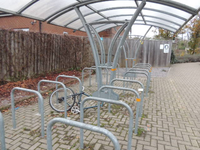The Reset Plan 2021-2025 version1, February 2021 has been published by the outgoing WSCC administration here.
It has been rushed through. Several of the Key Performance Indicators (KPI) are not even given base-line or target KPIs for the soon-to-be elected new Council. Many numbers don’t represent a ‘reset’ at all, they just confuse us.
I’m not saying there is nothing good in the Reset Plan.
*The high speed fibre backbone between Brighton and Crawley, and the new Mid Sussex Northern Arc Industrial Hub next to the A23 both make sense.
*The precept spend (shown on page 28 for non-accountants) is instructive as is the decreasing spend on ‘Place Services’ including highways and energy and Sustainability.
There is a Climate Change symbol (CC) to highlight attention to CC KPIs. But this symbol is displayed against just three KPIs in the entire document. There is no obvious linkage to 2050 let alone 2030! Let’s look at the CC KPIs in a bit more detail.
1. New cycle paths
KPI#17 The proposed target of 7.5km new cycle tracks each year is miniscule and misleading. It ignores where they are and whether or not they are used or maintained. What’s needed is Low Traffic Neighbourhoods in town centres to encourage people actually start riding their bikes in the 20 minutes zone where short car journeys prevail. Hence the KPI should be % of active journeys compared with car journeys. It could easily be estimated by vehicle parking officers. Bike racks filled with bikes dotted around our town centres can be a demonstration of success! Not like this one in Imberhorne Lane, East Grinstead.
2. Emissions from WSCC activities
KPI#22. The proposed reductions are laudable but insignificant. The KPI is reported in ‘tonnes of CO2 equivalent’ National energy reporting has since 2019 been standardised in multiples of kWh/year which is understandable and capable of scrutiny. See here. The KPI will be derived from energy reductions in the built environment, council officers’ transport and energy generation (PV farms) all KWh metrics in the first place. Is contractors’ energy aggregated into this KPI?
3. Household Waste % recycled, reused or composted
KPI#23. Almost certainly future reductions in this KPI will be achieved by separate collection of food waste, because currently there is no such collection in West Sussex nor any facility for dealing with it. Why has this not happened? One problem is that second tier authorities have to bear the cost of making the collections but WSCC control the marketplace. Separate disclosure of the three components of the KPI would reveal ‘Reuse’ is close to zero and the individual measured KPIs should be very simply reported in metric tonnes.
We need more CC KPIs
For example: Highway CO2 emissions in sub-regional local authority boundaries continue to increase year-on-year as evidenced here yet this WSCC reset plan has no KPI to measure it. The rise in emissions is due mainly to the increasing size and weight of cars especially SUVs, but also to the escalating number of cars on very short journeys and escalating van journeys due to out of control home deliveries. It will be argued that this is a parameter over which a local authority such as WSCC have no control. But committing to active travel schemes in the nine borough towns would bring health and air quality benefits to all residents. The recent squandering of central government funding on cycle lanes that were made and subsequently removed shows an out-of-touch administration.